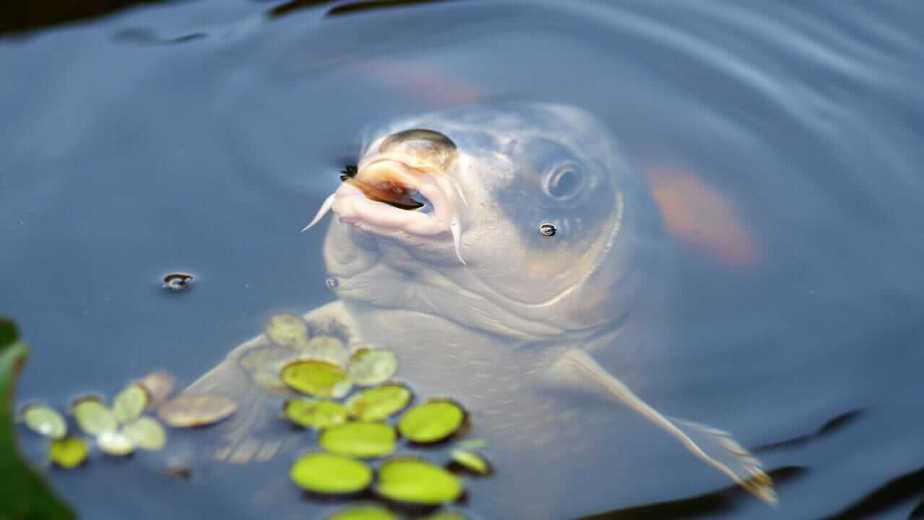When do carp spawn is the most common topic which needs proper exposure and explanation so that the information and knowledge can be used in the best practical form.
Carp usually spawn once in a year generally in January to March. But in regions with temperate weather they can spawn throughout the year. Within the natural geographical and environmental range, common carp spawn from late spring to early summer and is able to spawn at repeated occasions.
Carp is an umbrella term used for a group of fish which belong to phylum chordate. Carp are typically found in Europe and Asia and recently introduced in America as well. They belong to the family Cyprinidae. They have some common features like teeth and scales on the inferior pharyngeal bones which are modified according to the food they eat. Weberian ossicles are also common in the group of these fish.
When do Carp Spawn and Reproductive Cycle of These Species:
The most common type of carp is also termed as “common carp” or “European Carp.” The scientific name for common carp is Cyprinus Caprio. Other forms of carp are silver carp, common carp, grass carp, black carp, mud carp, bighead carp, and crucian carp.
Carp mostly live in the brackish or continental water, but they return to fresh water every time they have to spawn. It is an important food fish for human for ages. Carp fish are present in a variety of sizes from a small fish to larger species. Some carps are known as ornamental fish like goldfish and koi.
If someone wants to breed the carp in tropical or subtropical regions, the common carp may exhibit more than two or three spawning batches which are again linked to sufficient temperature and availability of proper and balanced food.
Reproduction Of Carp:
Spawning is the method by which carps reproduce. Spawning is the release of male and female gametes, and then their fertilization occurs resulting in new offspring. A common carp can lay eggs as numerous as three hundred thousand in a single spawn. It is important to know when about spawning if someone plans to breed them or keep them as pets.
First of all, we need to be able to differentiate between a male and a female carp. This information is particularly important if some sort of artificial breeding of carp is planned.
So generally, a female carp can be differentiated from a male carp by its shape. The body of the female carp is healthier and plump. The genital openings of the female carp are present above the papilla. On the other hand, a male carp is slender and comparatively thinner, and the genital openings are present behind the genital papilla.
A mature female carp will be differentiated from male carp by examining the belly and genital area of both. Female will have a soft and round belly with erect genital papilla which is reddish in color. Their anal opening is enlarged and protruding.
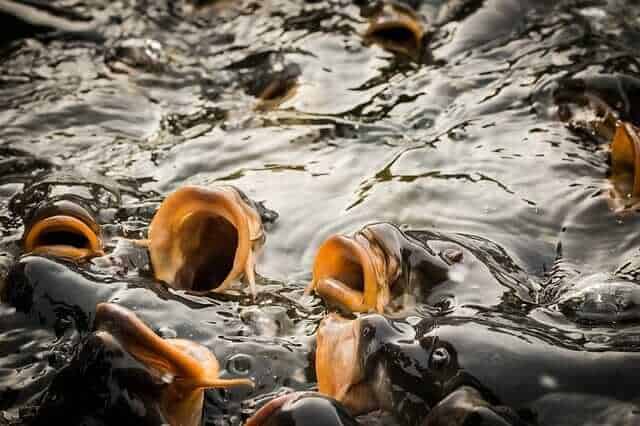
On the other hand, a spawning male will again be slender, and if slight abdominal pressure is exerted, they release milt. The belly of mature male carp is not as rounded or smooth as it is in case of female carp.
To completely understand the process of spawning, let’s look at the natural reproduction cycle of a common carp.
Overview Of The Reproductive Cycle Of Carp:
The lifecycle begins in an adult fish where eggs and sperms are fully mature and ready to fertilize after they have been spawned. Male sexual products or cells are sperms, and in female carp, they are called as eggs. Both lay their gonads in the water.
Once the eggs and sperms are released in the water, fertilization of some these occurs marking the beginning of new life. Fertilized egg now finds a place in water to stick on. Usually, they find vegetation, develop in them and stick there even in a non-feeding larval stage. After some time, larvae are developed enough to start feeding on the air, and then they start swimming. Mostly they swim in a horizontal manner initially. At this stage, they are able to feed externally.
Development of advanced fry takes place, and it is followed by the development of fish which is now one summer old already. After a summer or two, adult fish is now ready and is sexually mature for another round of reproduction.
Development of fertilized egg and larva
The text mentioned above was an overview of the reproduction cycle of a common carp. However, it is important to know the process of fertilization and development of larva here.
After fertilization, the fertilized egg swells and starts dividing by mitotic cell division. When it reaches eight cell stages, it is called the morula, then blastula and gastrula at 16 and 32 cells. After that, the fertilized egg is called an embryo.
The embryo develops into a larva which is called a hatched larva, which then grows into just feeding larva. This advances into the early stage of fry and then into advanced fry stage.
How eggs are produced in a female carp:
In the early few months of life of a female carp, gonads are formed in the shape of fiber-like initials. This is the stage when female ovary contains a primitive form of eggs. After the female matures, eggs are ready to be released and fertilized.
In carps, the eggs are matured in batches and develop into primary oocytes around which follicles form. Egg development then goes through several stages, and the size of these eggs begins to increase. Yolk accumulates in the end, and the final process is called as vitellogenesis. Eggs at this stage are ready but sleeping and waiting for a suitable environment for spawning.
When the environment becomes suitable for eggs, they are released into the water. This process is called ovulation.
Timing Of Carp Reproduction:
Reproduction of carps ideally occurs in the spring, but in areas of moderate climate, they can spawn throughout the year. Areas, where they spawn all year, are India, Michigan and some parts of Europe.
When do carp spawn? – The most common time for carp spawning is from April to July.
Where Do Carp Spawn?
When the carp spawn, they spawn in the fresh water. They may live in brackish water, or some survive in salt water. But at the time of spawning, they always move back to fresh water. If artificial breeding of carp is planned, it takes place in large hapas, cement tanks, and small ponds.
Spawning of carp is favored by shallow water with many plants. This is because they need vegetation for the attachment of larvae and feeding in their dormant stages.
Mating of male and female carp occurs in the shallow waters where weeds and planktons are available in plenty. They also prefer waters where there is freshly flooded grass which is easily available in tropical and subtropical climate areas.
Although the developing young fish become less and less fragile, they are incredibly vulnerable to predators.
What Do Spawning Carp Eat?
Carp eat almost everything present on earth. That is why they are considered omnivores. Since they mostly live in the middle and upper stream, they have to come to the bottom of the rivers and lakes and eat on animals, plants and mud present there.
If the carp are newly hatched, it will feed on plants and algae or smallest animals drifting in their ways. With the growth and reaching adulthood, they start eating fish and snails and other crustaceans as well. They can also feed on insects, plants, mollusks and small fish with their eggs.
Their mechanism of feeding is sucking from the mud present at the bottom of the lakes and rivers especially when the carp spawn. The places of their feeding can be easily identified in the shallow water where the mud is dug into small depressions.
Spawning carp feed on almost the same feed mentioned above. It is active in feeding just when it is ready to spawn, and the feeding is also highly dependent upon the temperature of water. If the temperature is above 75 or below 45 degree Farenheit, their feeding reduces.
According to the Food and Agriculture Organization by the United Nations, there is a certain requirement of food and nutrients for spawning carp. It is better to have a look at those daily requirements.
Protein requirements
Half a gram of protein per pound body weight of carp is required for the maintenance of protein reserves already present in an adult and sexually mature carp. If the protein intake is around 3-4 g per pound, the sources of protein in carp as a food for human becomes even better. Lysine amino acid among others should be 2-3 percent of total diet and 6% of the total protein diet.
Dietary lipids requirements
Carp being an omnivorous animal, can feed on all kinds of food. It needs a certain amount of lipids in diet just like proteins. FAO recommends 5-15 percent of daily lipids intake. They are especially useful and necessary for the survival of the larvae at a very early stage of life.
Dietary carbohydrate requirements
Glucose and maltose are two forms of sugar highly recommended to the adult carp. Starch cannot be given as easily because it is not digested as easily as in the higher animals. Ideally, glucose and maltose must be given four times a day to adult and sexually mature carp. The optimum range of dietary carbohydrate may be considered to be 30–40 percent for common carp, as proved by many studies in this field.
Vitamin requirements
Folic acid, B12, and Vitamin K and D are required by the spawning carp, and these are the very vitamins present in the fish in high amounts. Size of the carp, the temperature of the water in which they live, and the reproductive stage of their lives profoundly affect the daily requirements of vitamins in carp.
Do Carp Eat The Spawn?
If the food is scarce at an area where the fish spawn, it is quite possible that fish eat their own spawn. But it has to be kept in mind that carp don’t eat the entire batch of spawn. They always eat some of the spawn.
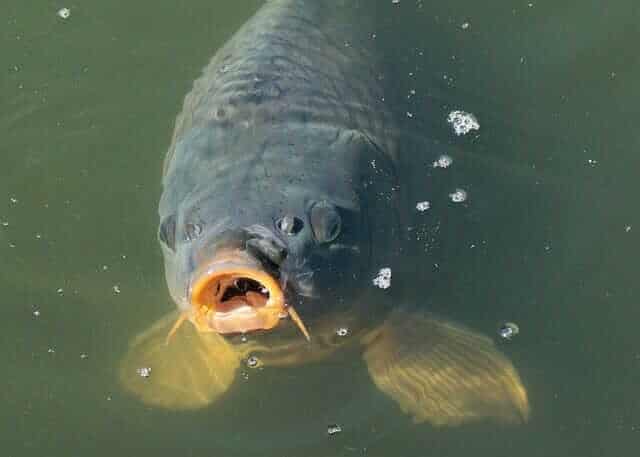
What Temperature Does The Water Should Be For The Carp To Spawn?
The ideal temperature for carp to spawn in fresh water is 64-75 degree Farenheit. Those who propagate the carp by artificial methods also make sure that the ponds and tanks are maintained at the above temperature.
When the carp spawn, There are other pre-requisites for carp to spawn in a better way. These factors are:
- Appropriate temperature as mentioned earlier
- Sufficient oxygen supply, approximately five to ten mg per liter
- Proper light is also required for which shallow water is the best choice
- Favorable atmosphere and its pressure
- Male sperms must be present around the area of spawning
- Vegetation must be available for spawning and attachment of larvae
How Long Does The Process Take?
The process of spawning, fertilization, and maturation of carp into an adult required one or two seasons. We can conveniently say that it takes a year or two for a carp to mature into an adult spawn which is again ready to reproduce into more carp.
The process of growth, however, is again much dependent upon the breed of the carp. Some take 2-5 months while some take 10-14 months for a complete cycle. It also depends upon the climate. Those areas where there is a moderate temperature all year long, carp can reproduce quickly and many times a year. Regions where winters are prevalent, they may spawn only once a year.
It takes almost 10-15 days for feeding larvae to grow and develop into an advanced fry state. After that, about a month or two are required to convert into an adult fish roughly.
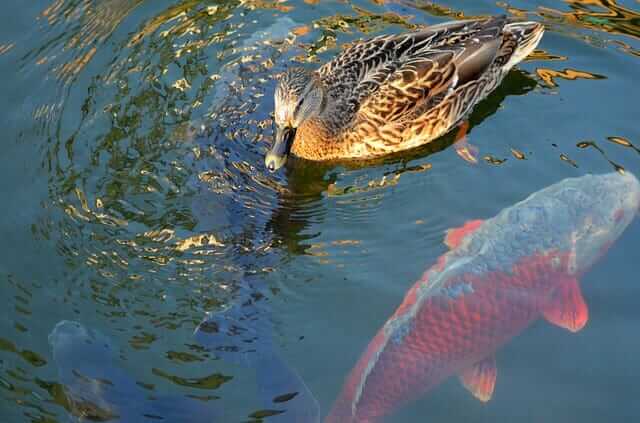
The process of growth, however, is again much dependent upon the breed of the carp. Some take 2-5 months while some take 10-14 months for a complete cycle. It also depends upon the climate. Those areas where there is a moderate temperature all year long, carp can reproduce quickly and many times a year. Regions where winters are prevalent, they may spawn only once a year.
It takes almost 10-15 days for feeding larvae to grow and develop into an advanced fry state. After that, about a month or two are required to convert into an adult fish roughly. The fish at this stage is called “fingerling.” Fingerling is usually known as “one summer old fish.”
It takes around 120 to 170 days for a fingerling to turn into a grower. A grower is a two summer old fish, and it weighs from 0.5 to 1 lb.
Another 170 days are utilized to convert a grower into table fish which reaches one kilogram in weight or higher in some cases.
Brood fish is the carp used for induced production, breeding, and propagation. It is an adult fish which is especially cultured and utilized to increase the carp production. The duration of its maturation is different for tropical, temperate and subtropical regions. Brood fish may weigh from 2 lbs to 9 lbs and sometimes more.
Therefore, the actual total gross period required for the production of 2– 6 lbs of large table fish may vary between about one and three years, while the net growing period for the same size of table fish will not be more than 0.8–1.3 years.
How Many Eggs Will Survive?
We can say conveniently, that only one percent of the eggs spawned in a single batch are able to develop into adult fish.
Male and female carp spawn side by side. They swim side by side. When a female carp spawns and spreads its eggs into the fresh water, a male carp also spawns and fertilizes the eggs. Those eggs which are fertilized enter the process of growth and development and remaining eggs may serve as food for the carp.
Until now, we have come to know that a single female carp can spawn thousands to millions of fresh carp eggs in a single spawn. Fertilization of many of these eggs is successful, but the research data has shown that the developing eggs and hatched larvae are poor to survive initially.
Carp Behavior When Spawning
Spawning carp exhibit potamodromous behavior at the time of spawning. This means that fish migrate between freshwater and seawater at the time of spawning. During breeding, the carp move to fresh and shallow water where they lay eggs in batches.
One spawn of carp can have thirty thousand to half a million eggs. The male carp keep fertilizing the eggs simultaneously.
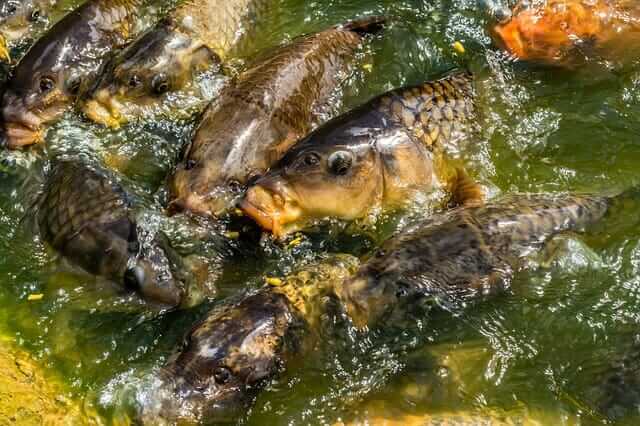
Some Artificial Methods Of Carp Propagation
Carp is one of the most commonly used fish for food, ornamental purposes and kept as pets. Its breeding is growing day by day, and a lot of artificial methods have been devised other than natural spawning of the carp. This is the main reason why carp are now found frequently in America as well.
It is one of the most widely known facts about the carp is that it has the most complex artificial propagation methods. There are many methods of artificial propagation of carp for which farmers who are interested in the fish culture and breeding are specially trained for these methods.
Artificial breeding is also valuable in breeding expensive species of the carp other than common carp. Examples of such carps are Chinese major carps, grass carps, silver carp, and bighead carps.
We shall discuss some of the most commonly used methods of spawning of carp especially recommended by FAO (Food and Agriculture organization by United Nations)
Nature-like spawning
In this type of breeding, no special measures are taken, only the environment is made favorable for the fish to spawn, fertilize and develop. Mature fish are kept in the freshwater ponds with a density of around three to four fish per hector area. Two to three males per female are spread into fresh water.
Semi-artificial spawning
In semi-artificial propagation, spawning is induced hormonally through injections. When the fresh pond water is favorable enough with respect to temperature, hypophysis injection is administered to adult brood fish. The dose is three milligrams per kilogram. The fish are then spread into freshwater pond equipped with vegetation, where fish can spawn after a day of injection.
Dubish method of spawning
In this method, small ponds are arranged with all the necessary requirements for breeding. The environment is created flood like where fish spawn. After fertilization and production of larvae, the parent fish are removed from the tanks.
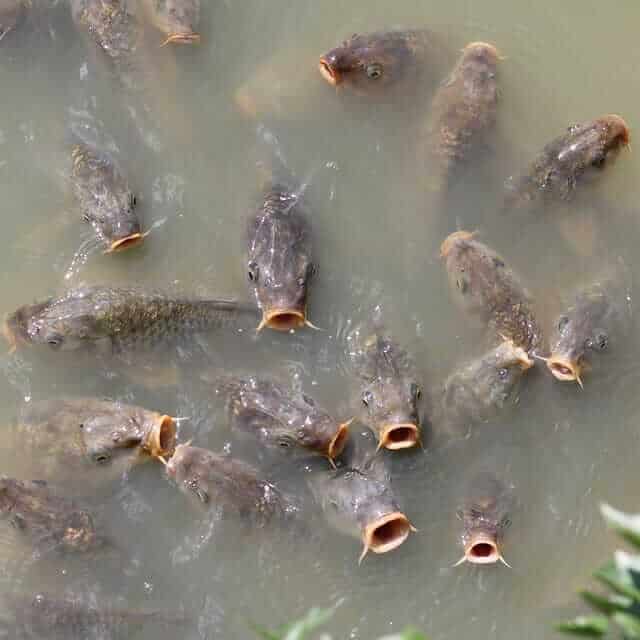
Artificial spawning
In this method, breeding is thoroughly planned, and each step is controlled. The first step is the administration of an injection with gonadotropic hormones after which the spawning takes place. After fertilization, the fertilized eggs are removed from the vegetation and are kept in hatchery jars under controlled conditions. Once the larvae are hatched, they are placed in large jars, which are later sent to nursery ponds after they start external feeding.
Sundanese method
It is widely used in Indonesia. The brood fishare kept separately, and once they are mature, they are sent to spawning ponds with installed nests called “kakabans.” Fish lay their eggs on kakabans after which they are shifted to nursing ponds.
Importance Of Carp Breeding And Spawning:
The most common type of fish found for eating and ornamental purposes is carp. Since carp form one of the largest groups of fish, they have a large variety of shape, form, color, and size. This makes their commercial use more practical.
Carp have an enormous ability to spawn and reproduce, and that is why they are bred in abundance. They may grow as large as 20-35 pounds which makes them ideal for food. The most commonly used fish as pets are also carp.
Goldfish is a well-known example. Ornamental carp are also bred. There is a vast study on lifecycle and breeding of carp for the same reason, and they are being bred commercially to serve all the purposes mentioned above.
